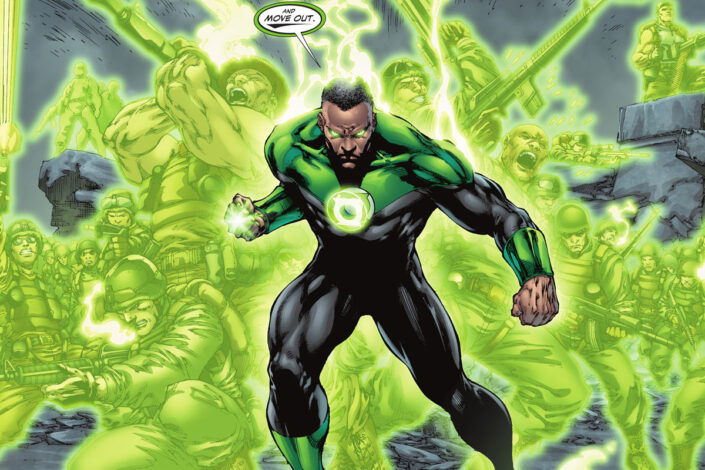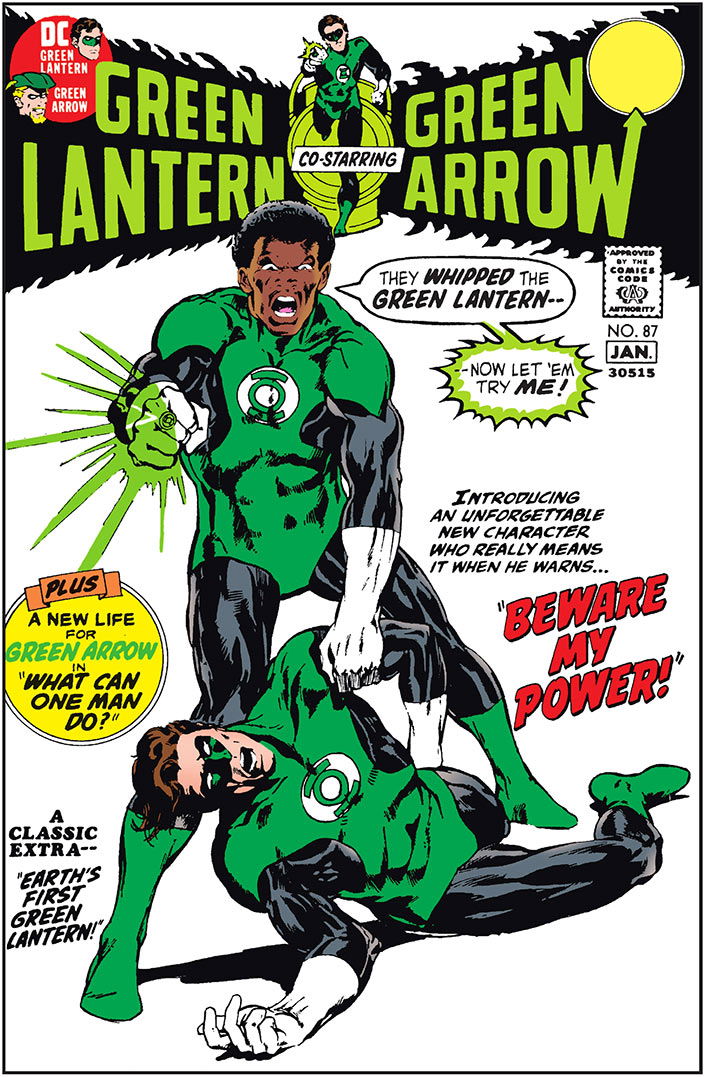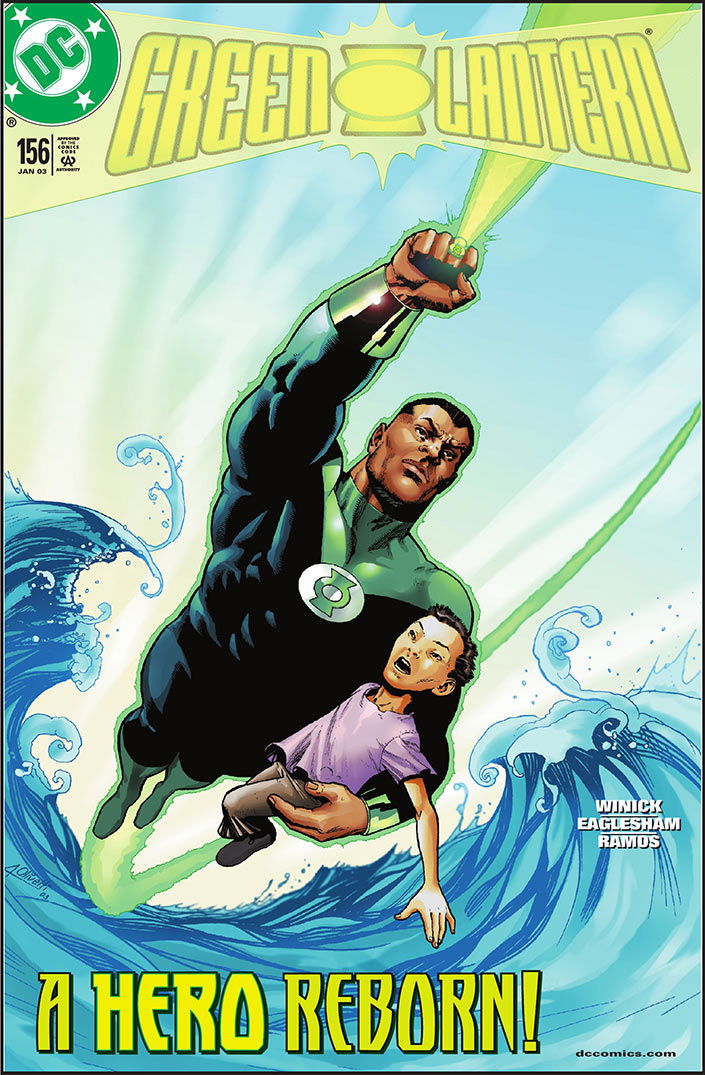
Among the Green Lanterns from Earth, John Stewart is one of the most popular and he may be gaining more fans soon as he is one of the main characters in the Green Lantern TV Show coming on HBO–played by actor Aaron Pierre.
Created by Dennis O’Neil and Neal Adams in Green Lantern vol. 2 #87 (1971), John Stewart was one of the first African-American superheroes to appear in DC Comics. Still, he didn’t immediately become one of the most prominent ones.
In fact, after this first appearance, he only came back four years later for a team-up with the Justice League of America (in Justice League of America #110, in 1974). He then continued to pop up only sporadically in Green Lantern comics until the mid-1980s with Crisis on Infinite Earths and his time as the main protector of sector 2814 in Green Lantern (from #182 to #200).
It was a slow start but John Stewart’s cosmic adventures are still going strong today.
The Creation of John Stewart
When working on their famous Green Lantern/Green Arrow series in the early 1970s, Dennis O’Neil and Neal Adams were known for tackling “relevant” subjects–including the renowned issue dedicated to Speedy’s heroin addiction, racism, corruption, pollution, poverty, and more. While discussing new ideas for the book, Adams asked then-editor Julius Schwartz about introducing a new backup Green Lantern.
There already was one, Guy Gardner, and for Neal Adams it made sense that if there was to be another Green Lantern, it would not necessarily be a white man. It’s a big planet, and all the best candidates for the job cannot be an Anglo-Saxon white protestant guy. The artist convinced his editor to go with an African-American lantern. But his fight to do it right only started here. He had to argue that the character should not be called “Lincoln Washington” but something more regular, like John Stewart. And then, there was the design.
There are also artists who, when they draw black people, draw a standard face. They have a face they think of and many of the things they do are controlled by their desire not to offend. In fact, some of these artists are Afro-American Themselves. That’s why my John Stewart looks unique and singular and like no other black face I have done.
–Neil Adams in conversation with Dan Johnson, in Back Issue #8 (Jan. 2005)
Neil Adams also requested changes to the coloring. When it came to characters with dark skin, Marvel Comics went with the color grey while DC Comics used the color khaki. For John Stewart, Adams went with dark brown, with more red in it. Once again, the idea that it could be offensive came up, but his choice made more sense than the other colors.
Ready to make his debut, John Stewart was introduced to Hal Jordan in Green Lantern vol. 2 #87. The Green Lantern offers to Stewart, then an architect without a job, the possibility to become a hero, and he takes it. Still an angry young man at the time, John’s style was not to Hal’s taste who has serious doubts about him, but those were pushed aside after a successful mission. The new Green Lantern gained the respect of Hal Jordan, but that was just the start.

The Evolution of John Stewart
The adventures of John Stewart as a Green Lantern were slow to begin. Once introduced, he disappeared for a few years, only occasionally filling in for Jordan when he was unavailable. In Green Lantern #182 (published in 1984), his time came to become the official protector of Sector 2814 where Earth is situated. Hal Jordan stepped down and the Green Lantern comics got a new headliner.
In that new position, John Stewart fought classic villains and was trained to better do his job by Lantern Katma Tui who eventually became his wife. But his run was not a long one. In Green Lantern #200, changes were introduced. The book was renamed Green Lantern Corps and focused not on one Lantern but on several of them. John Stewart was still there, but with Hal Jordan back at the forefront, he was pushed back. The comics lasted two years before one dramatic event put an end to the Corps as we knew it. The Central Power Battery of Oa started decaying. Hal saved it, but the energy left was not enough to sustain all remaining members of the Corps. John Stewart and Katma Tui went back to Earth, and Hal stayed with them for a while.
The adventures of the Green Lanterns were then moved to Action Comics as the comic book became an anthology starting issue #601–a major one for John Stewart as his wife was killed by Star Sapphire. During this storyline written by James Owsley (Christopher Priest), John is offered a chance to avenge Katma’s murder but ends up in a lot of trouble. When he is finally clear of any wrongdoing and is once again a ring-wearer, he is put on the road that would lead him to his biggest mistake.
Written by Jim Starlin and drawn by Mike Mignola, the 1988 Cosmic Odyssey miniseries puts John Stewart on a team with J’onn J’onzz (Martian Manhunter) as they must save the planet Xanshi menaced of destruction by an avatar of the Anti-Life Equation. Letting his hubris guide him, thinking he could save everybody by himself, John failed and millions lost their lives.
This event would haunt John Stewart forever. It also was the first clear step in the evolution of the character. The next came in the Green Lantern: Mosaic (1992-93) series. Introduced in Green Lantern (vol.3) #14-17, this spin-off series follows John Stewart as the caretaker of a strange, patchwork world—the Mosaic World—which consists of various alien cities and species forcibly relocated to Oa by the rogue Guardian Appa Ali Apsa. Often incompatible in culture and philosophy, these societies are thrown together, creating an intense and often volatile social experiment. The unique concept of this comics pushed John Stewart to navigate the political, cultural, and philosophical conflicts among the displaced communities while ensuring peace. It was a complicated situation that eventually reshaped him, making him more of a leader who gained a new cosmic awareness. He became a true hero capable of considering everyone else in building the resolution of conflicts.
But after that, the DC Comics editorial team decided it was time to have fewer Green Lanterns. Following the “Emerald Twilight” storyline, there would be only one (Kyle Rayner) in activity. Recruited by the Controllers, Stewart took command of the Darkstars, another interstellar peacekeeping force. During this time, John would become paralyzed following a fight against Darkseid’s son, but Hal Jordan would eventually heal him.
At that point, John Stewart had already changed from the angry young man he was to a respected and intelligent leader. However, his place in the DC Universe became less notable. It was with his apparition in another medium that he acquired the popularity he never had in the comics.
John Stewart: Military Man and Natural Leader
The popularity of the DC Comics Animated series had more than once influenced the story told in the comic books. In the case of John Stewart, his place among the other heroes in the Justice League animated show developed by Bruce Timm made him a popular hero among a new fan base. However, the version of the character on TV was different from the one in the comics. He was more of an action man with a military background. He was intelligent but never became an architect.
Some of those elements were introduced in the comics, mostly his military skills which played a big part in the way he was depicted as a leader in the Corps. His architectural career was not erased, though. This came into play during Geoff Johns’s extended run on the Green Lantern. Before this popular relaunch of the line, he already benefited from his growing popularity by replacing Kyle Rayner (starting in Green Lantern Vol. 3 #155), but the John Stewart he is now comes from Johns’s writings–starting with his Green Lantern Vol. 4 #26 (but it was really explored in Green Lantern Vol. 4 #49).
Today, John Stewart is one of the most respected Green Lanterns in the Corps. Because of his past experiences, he changed and became a true leader who, unlike some of his fellow Lanterns, is known to approach challenges with a measured, pragmatic mindset, often acting as the voice of reason in high-stakes situations. His capacity to combine his tactical expertise with a builder’s vision, using his background as both a Marine and an architect, to create intricate, large-scale constructs, but also to lead Lanterns into battle.
While no longer letting himself be defined by his past failures, he has learned from them the lessons that made him a mentor, a warrior, and a leader. Whether alongside the Green Lanterns or the Justice Leaguers, John Stewart has evolved as few comic book characters have. There is no going back for him, only forward, as it should be.
To explore the world of the Green Lanterns, you can go through our guide to reading the Green Lantern comics, discover who are the main Green Lanterns, or gain an understanding of the Emotional Spectrum.
